




When working long hours, you need to get outside from time to time.
Collections – ceramics and bricks in the material library.








When working long hours, you need to get outside from time to time.
Collections – ceramics and bricks in the material library.


Die Ausbildung zur Architektin oder zum Architekten erfolgt in fünf Jahren. Im dreijährigen Bachelor-Studium eignen Sie sich das breite Wissen an, das Sie später im Beruf benötigen. Im zweijährigen MasterStudium wird Ihnen anschliessend methodi sche Kompetenz vermittelt.
– Sie lernen in den verschiedenen Massstäben der Architektur zu denken und zu arbeiten.
Sie verbinden künstlerische Innovation mit wissenschaftlicher Arbeit. Sie forschen und handeln reflektiert und können über Ihre Arbeit schreiben. – Sie entwickeln eine eigene Haltung und vertreten diese nach aussen.
Der Master-Studiengang fokussiert auf den Entwurf und die Schreibpraxis. Nach dem Abschluss beherrschen Sie beides konsistent und kontinuierlich auf hohem Niveau. Das Studium ist in drei Entwurfsmodule geglie dert: Architektur & Energie, Architektur & Material sowie Architektur & Struktur. Diese Module sind international ausgerichtet und reflektieren gleichzeitig den regionalen Kontext von Bauten. Sie nehmen Themen aus der Forschung auf und vertiefen diese interdisziplinär.
Als Studentin oder Student profitieren Sie von zahlreichen Kooperationen, wie zum Beispiel mit dem Forschungsteam des Kompetenzzentrums Typologie & Planung in Architektur (CCTP) mit dem Institut für Gebäudetechnik und Energie, IGE, oder von unserer fünfjähri gen Zusammenarbeit mit dem renommierten Design Lab des Kyoto Institute of Technology
The five-year degree program for architects consists of two parts. During the three-year bachelor’s program, you will acquire the skills and knowledge required for the profession, while the consecutive two-year master’s program focuses on conveying methodological skills.
You will acquire the following skills:
– Thinking and working within the different scales applied to architecture.
Combining artistic innovation with scientific work.
Researching and acting in a reflective manner and writing about your work.
– Developing and championing your own position.
The master’s program focuses on design and writing practice – after its completion, you will be highly proficient in both. The program is divided into three design modules: Architecture and Energy, Architecture and Material, and Architecture and Structure. These modules are internationally oriented, yet reflective of a regional architectural context. Research topics are worked on in an interdisciplinary setting.
As a student, you will benefit from numerous cooperations, for instance with the the Competence Center Typology and Planning in Architecture (CCTP) the Institute of Building Technology and Energy, IGE, and our five-year research collaboration with the Kyoto Institute of Technology’s internationally renowned Design Lab into the culture of water in Switzerland and Japan. All Design Studios are available in any given semester.
zur Kultur des Wassers in der Schweiz und in Japan. Wir bieten alle Entwurfsstudios jedes Semster an.
Sie können das Master-Studium genau wie das Bachelor-Studium auch berufsbeglei tend absolvieren. Als Arbeitstage sind Mittwoch und Freitag vorgesehen.
Das Studium besteht aus zwei Regelsemestern (siehe Grafik Seite 10), einem dritten Semester mit unterschiedlichen Wahlmög lichkeiten und der Master-Thesis. Die Aufgabenstellung Ihrer Thesis können Sie auch selbstständig erarbeiten, um sich mit einem Architekturthema Ihrer Wahl auseinanderzusetzen. Die freie Master-Thesis unterstützt die Verknüpfung von Lehre und Forschung.
Im Master-Studiengang wird in den Theorieund Projektmodulen eine zweisprachige Kultur gepflegt, wobei die Vorlesungen auf Englisch gehalten werden.
Der Studiengang ist zweisprachig in Deutsch und Englisch. Die Theorievorlesungen sind mehrheitlich in Englisch, Arbeiten und Prüfungen können auf Deutsch oder Englisch abgegeben werden.
Personen mit deutscher Muttersprache müssen über ein Englischniveau auf mindes tens Niveau B2 verfügen, alle anderen Personen müssen zu Studienbeginn ein Englischniveau auf Stufe C1 vorweisen können.
You may choose a work-study track for both the bachelor’s or master’s program. Attendance is expected on Wednesdays and Fridays.
The program comprises two standard semesters (see diagram below), a third semester with various selection options and the master’s thesis. You may also independently develop your thesis research question and discuss an architectural topic of your choice. This free approach combines teaching and research.
We foster a culture of bilingualism in the theory and project modules of the Master’s program: the related lectures are held in English.
The degree program is taught in German and English.
The theory lectures are predominantly held in English, while coursework and exams may be submitted in German or English.
Prospective students with German as their native language are required to have English language skills at level B2 or higher - the remaining students must have skills at C1 at the start of the program.
Regular Semester
Regular Semester
Regular Semester
Exchange Semester
Exchange Semester
Master's Thesis
Preparation Free
Free Master's Thesis
Haben Sie Fragen?
Prof. Peter Althaus
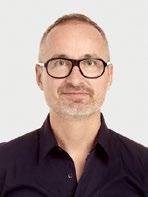
Bedingung für den Zugang zum MasterStudium Architektur ist ein FachhochschulDiplom oder ein Bachelor in Architektur einer Schweizer oder ausländischen Hoch schule. Das schweizweit abgestimmte Aufnahmeverfahren verlangt die Abgabe eines Portfolios und ein Aufnahmegespräch mit dem Studiengangleiter.
Der Einstieg ins Studium ist in jedem Semester möglich. Der Unterricht ist modular aufgebaut. Ein Semester besteht aus sechs Modulen, die als Einheiten abgeschlossen und bewertet werden.
Das Vollzeit-Master-Studium erstreckt sich einschliesslich der Thesis über mindestens vier Semester und umfasst 120 ECTSCredits. Das Entwurfsstudio (Modul «Fokusprojekt» bildet den Kern des Semesters.
Im dritten Semester können Sie ein Gast semester an unserer Partnerschule in Basel oder an einer der zahlreichen internationa len Partneruniversitäten absolvieren. Zudem besteht die Möglichkeit, ein im zweiten Semester erarbeitetes Projekt im Fokus Architektur & Umsetzung zu vertiefen oder eine freie Master-Thesis im Rahmen der Vertiefungsarbeit und der Keynote Lectures zu erarbeiten.
Die Master-Thesis beansprucht ein ganzes Semester. Sie wird von einer Dozentin oder einem Dozenten des Instituts für Architek tur auf Ihre Anfrage hin begleitet.
Applicants for the Master of Arts in Architecture program must hold a diploma from a university of applied sciences or a bachelor’s degree in Architecture from a Swiss university or a university abroad. The admission procedure is coordinated nationwide and requires applicants to submit a portfolio and sit an admission interview with the head of the degree program.
Students may commence their studies in either the spring or fall semester. The curriculum is modular in design. Each semester is divided into six modules, all of which are completed and graded independently.
The full-time master’s program is at least four semesters in length including the thesis project, and equivalent to 120 ECTS credits. The Design Studio (focus project module) constitutes the core of the semester.
You will have the opportunity to spend your third semester as a guest student at our partner school in Basel or at one of our partner universities abroad. Furthermore, there is the possibility to further explore your second semester project in the Architecture and Implementation focus project or to develop a free master’s thesis in the framework of your in-depth study and the keynote lectures.
Students have one semester to complete the master’s thesis, which is supervised by their assigned lecturer from the Institute of Architecture.
Unter dem Titel struktur_transfer beschäfti gen wir uns mit relevanten gesellschaftli chen Fragen und unserer Verantwortung für die Umwelt.
Der Begriff Struktur bezeichnet die Ordnung und das rationale Denken in der Architektur. Durch strukturiertes Denken erfassen wir Probleme. Anschliessend lösen wir diese durch ebenso strukturiertes Entwerfen. Dabei motivieren wir Sie, Ihre eigene Haltung zu finden. Sie lernen, sich zu hinterfragen, um eine individuelle, konsis tente Haltung zu finden.
Unser Strukturbegriff ist weit gefasst. Die Struktur prägt den Entwurf auf allen Ebenen, sie wird in jedem Projekt anders gewichtet. Sie besteht aus verschiedenen Komponenten, die sich gegenseitig beein flussen und in Einklang gebracht werden müssen:
Städtebauliche Struktur: Welche Bedeu tung hat ein Gebäude im Umfeld, wie beeinflusst der Ort den Raum und umgekehrt? Aber auch: Wie beeinflusst der Ort die Struktur innerhalb des Gebäudes?
Räumliche Struktur: Wie ist das Projekt räumlich organisiert und welchen räumli chen Prinzipien folgt es? Wie funktionie ren die räumliche und die statische Struktur zusammen?
Under the title structure_transfer, we are looking into relevant societal questions and our responsibility for the environment.
The term “structure” denotes the order and the rational thinking that shape architecture. Structured thinking helps us recognize problems, which we are then able to solve by applying an equally structured design process. Within this process, we encourage you to find your own position. You will learn to question your thinking in order to develop a unique and consistent position.
Our concept of structure is broadly defined. Structure influences the design process on each level and varies in significance depending on the project. It comprises various components of mutual influence, which must be brought into harmony:
– Urban structure: What is a building’s significance in the context of its environment, how does a location influence the space around it and vice versa? But also this: How does a location influence the structure within a building?
Spatial structure: How is a building organized in terms of space and which spatial principles have been employed in its design? How do the spatial and the static structures interact?
A new (high-rise building) project for Lugano.
Tragende Struktur: Wie kann ein Konzept für ein Tragwerk entwickelt und umge setzt werden? Kann die Tragstruktur auch im übertragenen Sinn tragend für ein Projekt werden?
Infrastruktur: Ein Projekt lebt von der Bewegung. Wie können Verkehrsflüsse in den Entwurf einbezogen werden und wie funktioniert die Struktur des Entwurfes? Wie verhält sich das Projekt zur urbanen Infrastruktur?

Das Institut für Bauingenieurwesen stellt Ihnen für die gesamte Dauer Fachexpertin nen und -experten für Tragstruktur zur Verfügung.
Bearing structure: How to best develop and implement a concept for a bearing structure? Does the latter also have the ability to support a project in a metaphorical sense?
Infrastructure: Movement is at the heart of every project. How can traffic flows be integrated into a design and what are the underlying principles of the design’s own structure? What is the project’s relation to the surrounding urban infrastructure?
Bearing structure experts from the Institute for Civil Engineering will support you throughout the program.
Sie entwickeln eine Architektursprache in der Auseinandersetzung mit Energieflüssen im Gebäude. Bauphysik und Komfort betrachten wir als zentrale Themen für Architektinnen und Architektenmit denen Sie Ihre Fähigkeiten erweitern. Sie lernen energetische Herausforderungen in einem Kontext zu lösen und früh in Ihre Entwürfe zu integrieren.
Der Fokus Architektur & Energie sensibilisiert Sie für den immer wichtiger werdenden Diskurs in Nachhaltigkeitsfragen jenseits von Energie-Labels und gebäudetechnischer Auseinandersetzung.
Im forschenden Entwerfen setzen Sie sich mit folgenden Themen auseinander:
Klima (einwirkende Energie): Hitze, Kälte, Luftfeuchtigkeit, Windverhältnisse, Niederschlag, Sonnenstand, Jahreszeiten. Auf der Suche nach architektonischen Lösungen für einen spezifischen Klima kontext interessieren wir uns für Beispiele traditioneller und historischer Architektur.
Ressourcen (graue Energie): lokale Materialien, Bauprozess, Mobilität, Lebensdauer, Anpassbarkeit. Ziel der Abwägung zu Einsatz und Ertrag ist immer die Verhältnismässigkeit der Mittel.
– Nutzung (Betriebsenergie): Raumbedarf, Behaglichkeit, Tageslicht, Abwärme. Beim Ausloten des Notwendigen versuchen wir neue Optimierungen zu finden.
You will develop an architectural language by analyzing the energy flow within a building. We consider construction physics and comfort to be key issues for architects to expand their knowledge around. They learn to address energy-related challenges in a broader context and and to consider them early on in the design processes.
The Architecture and Energy Focus raises the students’ awareness for an increasingly important sustainability discourse beyond energy labels and challenges relating to building technology.
By engaging in research-based design, you are confronted with the following topics:
Climate (impacting energy): Heat, cold, humidity, wind conditions, precipitation, solar altitude, seasons. Searching for architectural solutions for a specific climatic context, we study traditional and historic buildings.
Resources (gray energy): local materials, building process, mobility, life cycles, adaptability. Proportionality must always be a main consideration when balancing means and results.
Comfort (operating energy): Mood, comfort, daylight, room requirements, waste heat. While exploring what is necessary, we look into questions relating to atmosphere, optimization and sufficiency.
Um die Relevanz von Klima, Nutzung und Ressourcen für den Entwurf zu verstehen, ist es wichtig, dass Sie nicht nur Architektur und Konstruktion verstehen. Dazu sind auch Kenntnisse in Bauphysik und Gebäudetech nik erforderlich. Sie lernen wichtige techni sche Grundlagen, so dass Sie später in Zusammenarbeit mit Ingenieurinnen und Ingenieuren kompetent verhandeln und ent scheiden können.
In order to appreciate the relevance of climate, utilization and resources for the design process, it is important that your expertise extends beyond architecture and construction and includes construction physics as well as building technology. You will learn essential technical principles to enable a productive and competent future interaction and collaboration with engineers.
Passionately discussing the spaces of tomorrow.
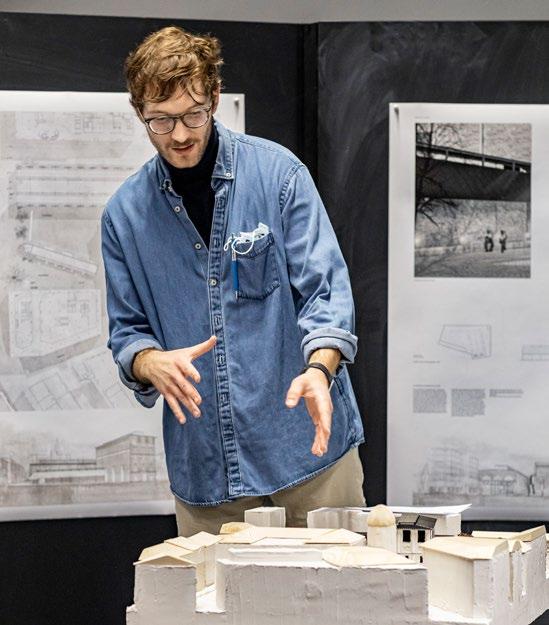
Mit Material meinen wir stets sämtliche Bedeutungsebenen, stoffliche wie inhalt liche. Wir sprechen vom konkreten Bauen, aber genauso von der Landschaft, ihren klimatischen Bedingungen und kulturellen Eigenheiten. Material ist für uns willkom mene grundlegende Vorbedingung und resonanter Widerstand, um mittels lokaler Fragestellungen für gesamtheitliche Zusammenhänge und drängende Aufgaben zu sensibilisieren.
Präsenz «Bauen ist eine zutiefst menschliche Tätigkeit, als Ergebnis des beständigen Ringens des Menschen mit seiner Umwelt.» Materialisierung und Plastizität wirken körperlich, sinnlich und direkt. Diesem berührenden Wechselspiel von konstruktiver Machart und Ausdruck spüren wir von Beginn weg nach.
Sorgfalt Strategisch gerüstet, werden Sie lernen, gründlich und umsichtig zu arbeiten. «Wie man entwirft, prägt was man entwirft.» Daher werden Sie verschiedenster Werk zeuge und entwerferischer Zugänge ermäch tigt, die eine integrative Betrachtungsweise fördern. Sie erfahren, wie Sie verschiedentlich gelagerte, anfänglich divergierende Anforderungen bis hin zu kulturhistorischen und anthropologischen Kontexten ineinan derfliessen lassen können. Ihre Wahrneh mung wird sich verfeinern. Ihre Kopf-HandVerbindung ist bei digitalen und analogen Mitteln fortan weniger Hürde, sondern Grundlage für zukünftige architektonische Sprachlichkeit und Eloquenz.
Using the term «material», we always refer to every layer of meaning, both physical and in terms of content. We talk about actual construction, but equally about the landscape, its climatic conditions, and its cultural identity. For us, material is a welcome foundational predisposition and offers resonating resistance in order for us to discuss site-specific issues, thus creating awareness for holistic contexts and pressing concerns.
Presence “Building is a deeply humane activity, the result of mankind’s perpetual struggle with its environment“. Materialization and plasticity are physically sensual and direct in appearance. This touching interplay of constructive design and expression is what we pursue from the start.
Diligence Equipped with the strategic tools, you will learn to work with rigor and diligence. “The way you design shapes what you design”. To this end, you will familiarize yourself with various instruments and design approaches that foster an integrated perspective. You will learn to work within and integrate variously disposed and initially diverging requirements, up to and including cultural-historical and anthropological contexts. You will refine your perception. Using digital and analogue tools, the connection between your head and hand will no longer be an obstacle, becoming instead a basis for your future architectural vocabulary and eloquence.
Significance Your design’s condensed “fabric of meaning” that incorporates questions of topos, tectonics and type will sharpen your
Signifikanz Die verdichteten «Sinngeflechte» ihres Entwurf zu Fragen des Topos, der Tektonik und des Typus wird Ihre architektonische Intention nie unscharf, sondern substanziell werden lassen. Sämtliche Operanden werden sich in den Dienst einer alles durchdringenden Intention stellen. Essenz und Spirit werden signifikant – und gegenüber vermeintlichen Änderungswün schen widerstandsfähig. Sie spüren, wann ein Projekt fertig ist.
Offenheit Wir arbeiten im Atelier. Gemein schaftlich. Wir erleben konkrete Orte und Menschen. Wir setzen uns in Beziehung und reiben uns am Vorgefundenen. Dennoch wollen wir Unkonkretes, die Absenz von Material zulassen und uns unbekannten Bedeutungsräumen öffnen.
architectural intention and make it substantial. Each facet will contribute to the expression of an all-pervasive intention. Essence and spirit become significant and resilient against ostensible requests for change. You will sense when a project is finished.
Openness We work in the studio. Communally. We experience concrete places and people. We connect with each other and we confront what we encounter. Nonetheless, we embrace the vague, the absence of material, and open ourselves to unknown semantic spaces.
Suitcase – a transporta ble model, The culture of Water.
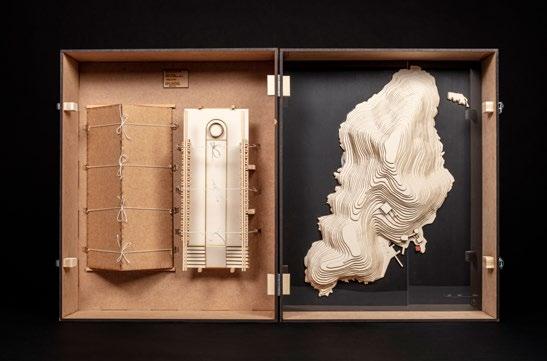
Montag Monday
Fokusvorlesungen
Dienstag Tuesday
Mittwoch Wednesday
Focus lectures
Vertiefungsarbeit In-depth study
Open Studio Project Work Open Studio
Freitag Friday
3
Basisvorlesungen
For organizational and administrative reasons, we recommend you sign up for the program at least four months before the commencement of studies. Later registrations are possible as well. Apply now on hslu.ch/jetzt
Looking for more than just a roof over your head to live and study? The Lucerne School of Engineering and Architecture offers housing for students and exchange students. housing@hslu.ch
Basic lectures
Studienreise (1 Woche pro Semester) Study trip (1 week per semester)
Lucerne UASA offers an attractive and wide-ranging sports program: unilu.ch/en/life-at-university/ sports/
6 ECTS-Credit-Angabe (hier 6 Credits) ECTS-credits (6 credits in this case)
Donnerstag Thursday 12
Studio betreut Project Work Studio supervised
You may be eligible for grants or scholarships. If you are studying for your first degree, please contact your parents’ Canton or country of residence. For further information, visit hslu.ch/scholarships
year start:
Fokusprojekt* Open Studio Project Work* Open Studio
Keynote Lectu res**
Contact Prof. Urs Grüter for all Swiss military matters: urs.grueter@hslu.ch
3
* Alternierend mit Keynote Lectures Alternating with Keynote Lectures ** Alternierend mit Fokusprojekt; Keynote Lectures finden abwechslungsweise in Luzern und Basel statt. Alternating with Project Work; Keynote Lectures held alternately in Lucerne and Basel.
In our project spaces and labs, you will work with a practical and interdisciplinary focus. Particularly convenient: the technical library with its broad range of media is a short ten steps away from the cafeteria.
break
ready for a sustainable and digitally transformed working world with our degree programs.
you want to prepare yourself for future self-employment? The Smart-up scheme provides support and advice. hslu.ch/smart-up
Our programs are designed to fit your needs. You can choose from a range of time models, shape the key elements of your program or fill specific gaps in your previous education.
Teaching at our School is interdisciplinary. You will closely collaborate with students from other programs. More than half of our modules are available to students from more than one program.
semester
Woche
Semester)
We provide you with the skills for your future career. Students closely collaborate with real-life businesses throughout their program, including their thesis projects.
Are you more of a mountain or a city person? Our campus is conveniently located and easy to reach from both rural and urban areas. hslu.ch/ta-standort
year start:
Nebst Ihrer Intuition prägt die Beschäfti gung mit architektonischen Themen Ihre Entwurfsfähigkeiten. Die Auseinandersetzung mit theoretischen Texten hilft Ihnen dabei, Ihr Wissen zu erweitern, Ihr Handeln zu reflektieren und eine persönliche Haltung zu entwickeln.
Im Vertiefungsmodul legen wir hohen Wert darauf, dass Sie Ihr Wissen in Architekturtheorie und -geschichte erweitern. Sie schrei ben in jedem Semester eine Textarbeit und widmen sich dabei einem definierten Thema innerhalb eines frei erarbeiteten Forschungsgebiets. Das Semesterthema wird mit Gastvorträgen, Lektüreseminaren und Besichtigungen eingeführt.
Im Anschluss erarbeiten Sie sich durch Lektüre und Recherche die Grundlagen, um später Ihre Gedanken auszuformulieren und einen essayartigen wissenschaftlichen Text zu verfassen.
Your design skills are informed by intuition and by studying architectural topics. Reading textbooks helps you to expand your skills and knowledge, to reflect on your actions and to develop a personal position.
We place great value on expanding your knowledge of architectural theory and history in the In-depth Study Module. Every semester, you are required to write a paper about a defined topic within an independently developed research area. The semester’s topic will be introduced through a range of guest lectures, lecture seminars and field trips.
Subsequently, you will acquire the fundamentals through reading and research which, in turn, will enable you to express your thoughts in an essay-like scientific text.
Site visit – Pastoor van Ars church by Aldo van Eyck.
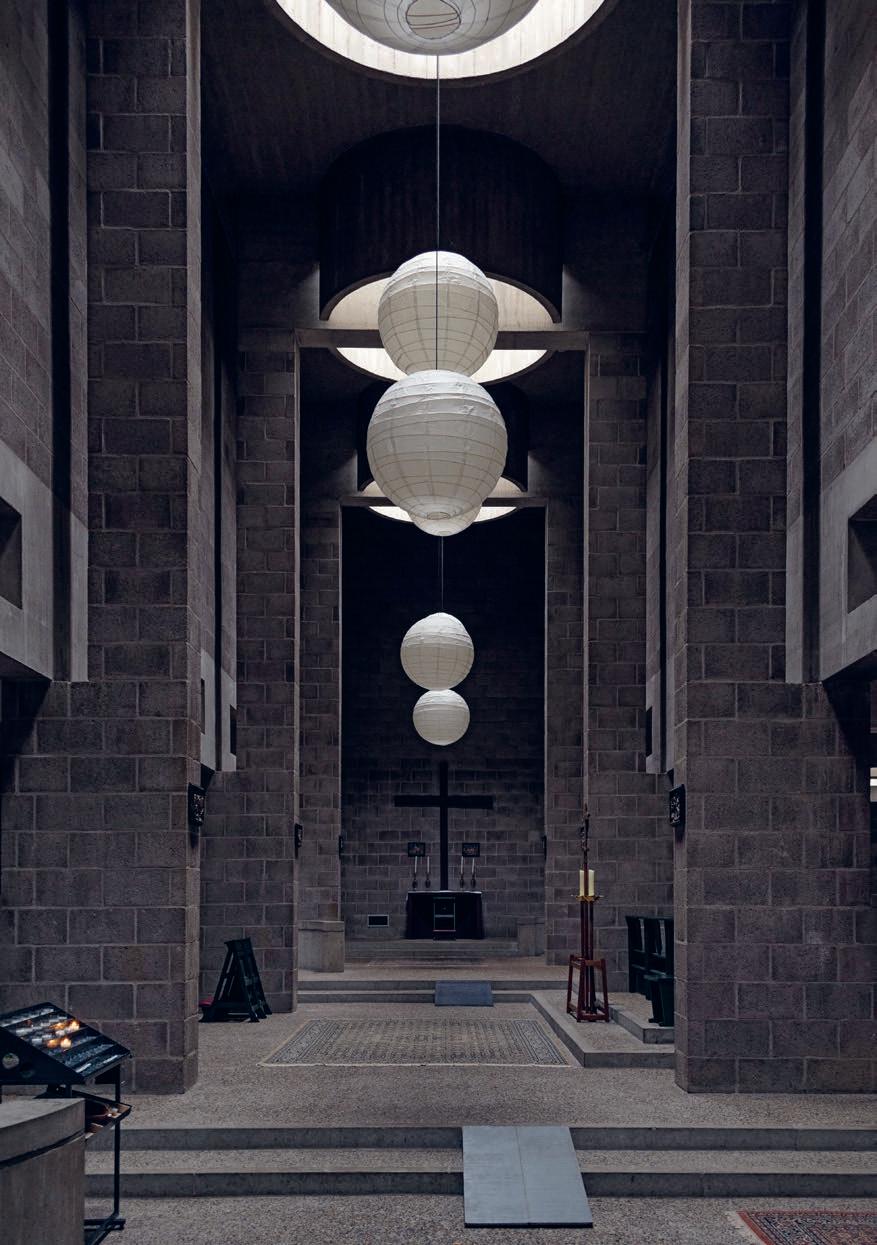
Architektur und Struktur, Architektur und Energie sowie Architektur und Material
Sie wenden Ihr Wissen in komplexen Entwurfsaufgaben an und entwickeln es weiter. Indem Sie sich vertieft mit wichtigen Themen auseinandersetzen, entwickeln Sie eine eigene Haltung. Das Fokusprojekt entsteht in enger Zusammenarbeit mit den Instituten des Fachbereichs Bau der Hoch schule Luzern – Technik & Architektur. Regelmässige Tischgespräche, Diskussionen in der Gruppe und mit Expertinnen und Experten sowie Zwischen- und Schlusskriti ken begleiten Ihre Arbeit. Ziel ist das Erarbeiten architektonischer Entwürfe, die das Entwickeln einer eigenen Haltung in der Architektur fördern.
Die Vertiefungsarbeit lehrt Sie wissenschaftliche Arbeitsmethoden und forschendes Denken. Sie schreiben während des Semes ters eine wissenschaftliche Arbeit zu einem relevanten Thema. Begleitet wird das Programm von Workshops, Diskussionen, Tisch-, Zwischen- und Schlusskritiken. Am Semesterende legen Sie eine verdich tete schriftliche Abhandlung vor, welche tief in eine theoretische Auseinandersetzung hineinführt.
Die Vorlesungen behandeln das Thema verschiedener Formen von Repräsentation, untersucht durch die Auseinandersetzung mit einer Nebensache: ein Motiv, eine Ergänzung, ein Detail. Die Motivanalyse dient dabei als Steigbügel für den Einstieg in zeitgenössische und historische Debatten rund um das Material und die Medien der Architektur. Unter welchen Umständen wird ein solches Detail zu einem Hinweis, der die Geschichte und unsere bisherige Vorstellung davon entschlüsselt? Wann enthüllt eine Ergänzung etwas bisher Unbekanntes? Der Kurs soll eigenständige Forschung und unkonventionellen Umgang mit Entwurfskonventionen fördern. Im Modul wird die präzise Lektüre von Bildern und Texten gefordert und die Studierenden bereiten Präsentationen und Essays vor.
ECTS: 3 Credits
Project work in the Architecture and Structure, Architecture and Energy, as well as Architecture and Material studios. You will apply your skills and knowledge in complex design assignments. By studying in-depth the key issues of your discipline, you will develop your individual position. The focus project emerges in close collaboration between the institutes within the Lucerne School of Engineering and Architecture’s Field of Building and Construction. Your work is complemented by regular round-table talks, group and expert discussions, as well as interim and final reviews. The aim of the modules is the development of architectural designs that help consolidate a personal position.
ECTS: 12 credits
In this module, you will be taught scientific methods and research-based thinking. You will be required to write a scientific paper about a relevant topic. The program is complemented by regular workshops and discussions, as well as round-table, interim and final reviews. At the end of the semester, you will present a concentrated written paper in which you deeply explore a theoretical issue.
ECTS: 6 credits
These lectures are on varied questions of representation, understood through the study of a question from the margins: a motif, a supplement, a detail. Motif analysis acts as the vehicle, with which we can enter into both contemporary and historical debates around both the material and the media of architecture. Open questions will appear frequently. Under what circumstances does such a detail become a clue that unravels history as we have hitherto imagined it? When does a supplement reveal something unknown at the core of practice? The course will foster both independent research, and experimentation with design conventions. The course will require close readings of both images and texts, and will require students to prepare both presentations and essays.
ECTS: 3 credits
Sie vermitteln Grundlagenwissen in Architekturtheorie und -geschichte durch Seminare, Übungen, Vorlesungen und Exkursionen.
ECTS: 3 Credits
Die Keynote Lectures bieten die Möglichkeit, in sechs ganztägigen Seminaren und Workshops mit teilweise fachfremden Referentinnen und Referenten von aussen auf architekturspezifische Themen zu blicken. In Einzel- und Gruppenarbeiten stehen methodische, strategische und performative Prozesse im Vordergrund. Die Unterrichtssprache ist Englisch.
ECTS: 3 Credits
Jedes Semester stehen Ihnen ein bis zwei aus den Entwurfsstudios organisierte Studienreisen zur Auswahl. Die Reisen finden in der Regel themenspezifisch statt.
ECTS: 3 Credits
Die Master-Thesis wird im letzten Semester absolviert. Sie arbeiten selbstständig an einem komplexen Projekt und wählen eine Betreuerin oder einen Betreuer unter allen Dozierenden des Instituts oder den Studien gangleiter aus. Thema ist eine vom Studiengangleiter gestellte Aufgabe. Nach Abspra che mit ihm ist es möglich, ein freies Master-Thesis-Projekt zu wählen. Die Projektarbeit wird in Form von Präsentatio nen, Diskussionen und Kritiken begleitet. ECTS: 21 Credits
Aufbauend auf den Methoden des wissen schaftlichen Arbeitens und Denkens unter suchen Sie Themen im Zusammenhang mit Ihrem Thesisprojekt. Zusätzlich beinhaltet das Thesisbuch die Projektaufgabe und ihre architektonische Umsetzung. So festigen Sie Ihre architektonische Haltung. ECTS: 9 Credits
In the basic lectures, foundational knowledge in architectural theory and history are taught through seminars, exercises, lectures and excursions.
ECTS: 3 credits
In six one-day seminars and workshops, the keynote lectures which, in part, feature speakers from other disciplines, offer the opportunity to look at architecture-related topics from an outside perspective. Individual and group projects focus on methodical, strategic and performative processes. The language of instruction is English.
ECTS: 3 credits
Each semester, you will be able to sign up for up to two study trips organized by one of the design studios. The trips are generally organized around a specific topic.
ECTS: 3 credits
The master’s thesis is completed in the final semester. After selecting a supervisor from among the faculty (including the head) of your degree program, you will independently work on a complex project. The thesis topic will be assigned by the head of degree program. However, upon consultation with the latter, you may alternatively opt to develop your own master’s thesis topic. The project work is complemented by presentations, discussions and reviews.
ECTS: 21 credits
Building on an academic approach and mindset, you will explore issues relevant to your thesis project. The thesis book also includes the thesis project task as well as its architectural realization, supporting you in developing an architectural position.
ECTS: 9 credits
Der Master-Studiengang des Instituts für Architektur und des Design-Lab am Kyoto Institute of Technology führt ein fünfjähriges gemeinsames Entwurfsstudio zur Kultur des Wassers. Innerhalb dieser Kooperation wird sich jedes Entwurfsstudio mindestens einmal mit der Kultur des Wasser in Japan und in der Schweiz auseinandersetzen.
Bei diesem langfristig angelegten Projekt geht es im weitesten Sinn um den Einfluss des Wassers auf die Architektur.
Wasser hat ein riesiges Potenzial, auch narrativ. Sein sanftes, aber ausdrucksstarkes Erscheinungsbild ist Bezugs- und Ausgangspunkt für die Architektur.
Folgende Themen beschäftigen uns:
Wasser und Gefahr Zuerst widmete sich die Architektur der Aufgabe, die Kraft des Wassers zu kontrollieren. Überschwemmungen, Erosionen, Lawinen, Schnee und Regen beeinflussen die Baukultur stark. Genauso bestimmte das Wasser einst den Standort und die Struktur von Siedlungen, die Form von Gebäuden und deren Baustil.
Wasser und Versorgung Wasser ist einer der wichtigsten Rohstoffe des Menschen. Es beeinflusst bis heute die soziale und räumliche Ordnung einer Gesellschaft. Zu dem ist Wasser ein Medium, das die Grundlage gemeinschaftlicher Güter bildet. So waren und sind Brunnen zum Beispiel wichtige Zentren menschlicher Interaktion.
The Institute of Architecture’s master’s program and the Kyoto Institute of Technology’s Design Lab offer a joint five-year design studio focussing on the culture of water. In the framework of this cooperation, each design studio will address the culture of water in both Japan and Switzerland at least once.
The topic is set around the influence of water on architecture.
Water has an immense narrative potential. Its gentle, yet expressive appearance acts as both a point of reference and departure in architecture.
We are interested in the following topics:
Water and danger Initially, the main task of architecture was to protect us from the power of water. Floods, erosion, avalanches, snow and rain have therefore had a defining impact on building culture. But water also used to be a key factor determining the location and structure of settlements and the shape and architectural style of buildings.
Water and supply Water is one of the most important commodities for humankind – to this day, it shapes a society’s social and spatial organization. Water as a medium also forms the basis for common goods. Water wells, for instance, have always been important hubs for human interaction.
Wasser und Verkehr, Produktion und Entsorgung Schon lange vor der Industri alisierung war Wasser ein wichtiger Transportkanal. Gelenkte Wasserströme strukturieren Landschaften und Siedlun gen. Wasser ist so zu einem zentralen Organisationselement von Regionen und Wohnstätten geworden.
– Wasser und die Wahrnehmung der Landschaft Zu Beginn der Industrialisie rung wurde die Landschaft glorifiziert –und mit ihr das Wasser, das die Land schaft spiegelt und unendlich erscheinen lässt. So interagieren Haus und Wasser szenografisch.
Wasser und Wohlbefinden Wasser wirkt auf Menschen und ihre Sinne, besonders in seinem natürlichen Umfeld. Wir finden Genuss daran, seine Wirkung zu erleben, und nehmen Wasser als Teil des Klimas wahr.
Water and transportation, production and disposal Flowing waters were used as channels for transportation long before the dawn of industrialization. Landscapes and settlements are structured by channeled streams. Water has thus become a central organizational element for both regions and dwellings.
In the early days of industrialization, the landscape was glorified, and with it the water which mirrored and multiplied its surface. Building and water are thus interacting in a scenographic performance.
Water has an effect on humans and their senses, particularly in a natural setting. We enjoy experiencing this effect and we perceive water as an aspect of climate.
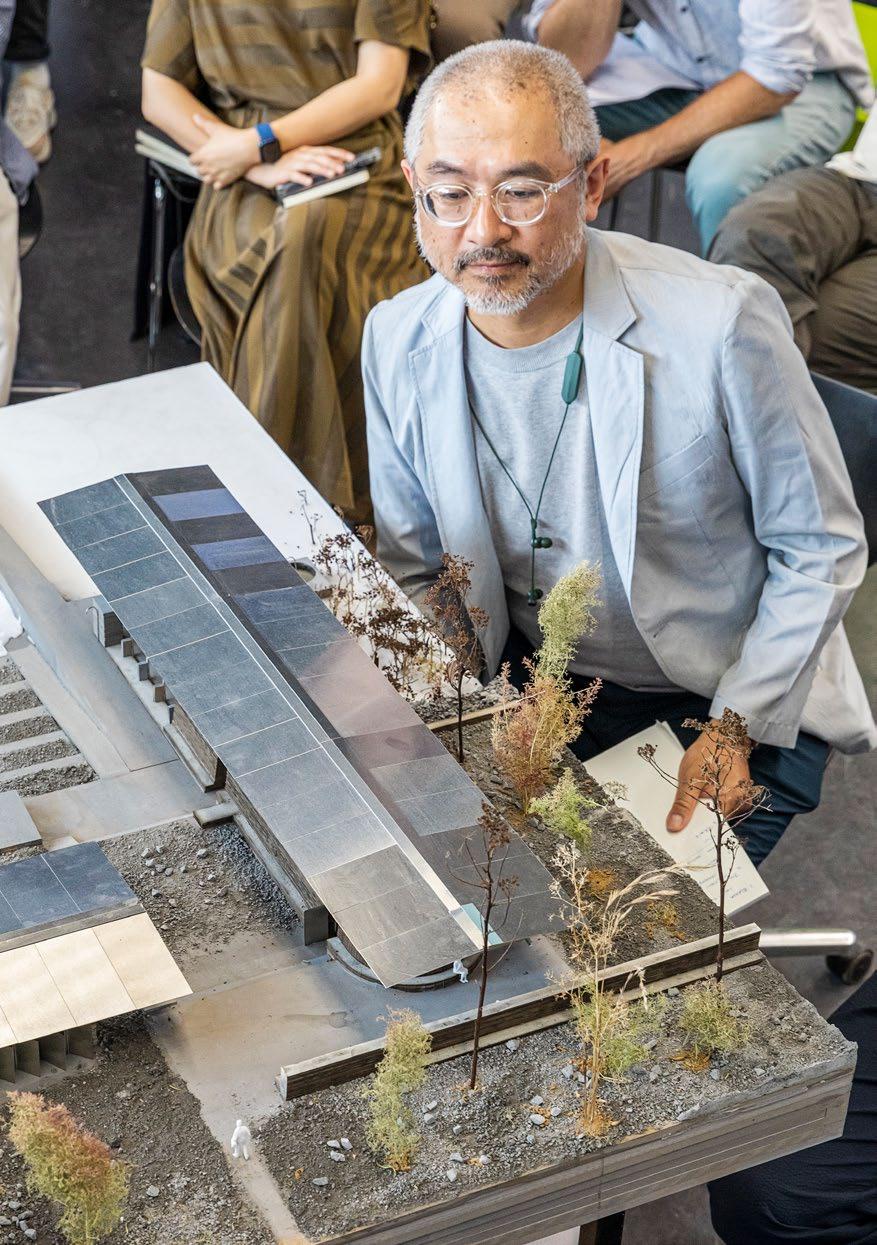
The best opportunity to turn your designs into reality –Summer School. International guests, sharing their thoughts.
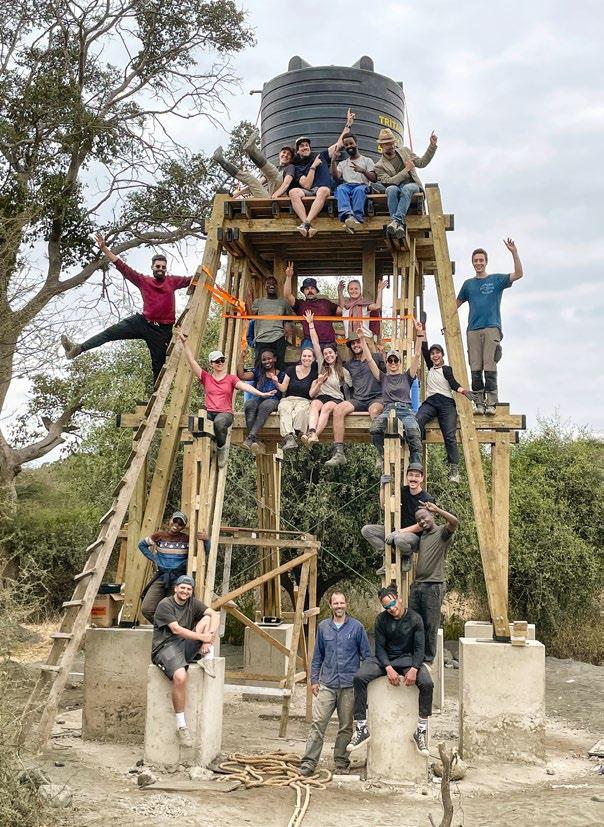
Das Kompetenzzentrum Typologie & Planung in Architektur (CCTP) erforscht die Interaktion zwischen Mensch und Architektur. Es beschäftigt sich vor allem mit der Frage, wie sich dabei der gebaute Lebens raum verändert.
Unsere Städte und Gebäude müssen sich permanent anpassen. Das ist eine wichtige gesellschaftliche Aufgabe. Das CCTP analysiert heutige Zustände und entwickelt Konzepte für die Zukunft. In enger Zusam menarbeit mit Forschung und Wirtschaft entstehen Lösungen für die Praxis, zum Beispiel, um Gebäude und Siedlungen resilienter zu machen und Städte zukunftsfähig zu entwickeln.
Das CCTP untersucht Systemverhalten und die Wirkung und Potenziale verschiedener Gebäude- und Siedlungstypen. Es versucht stets, benutzerfreundlichere Lösungen zu entwickeln und Mehrwerte für Mensch und Umwelt zu schaffen. Hierbei sind die folgenden vier Betrachtungsebenen (BE) und die Grundlagenforschung (GF) in den Themenfeldern Architektur und Raum entwicklung zentral:
–
BE 1: Material & Konstruktion
BE 2: Struktur & Gebäude
BE 3: Quartier & Raumentwicklung
BE 4: Interaktion & Prozesse
GF: Grundlagen & Methoden
The Competence Center Typology and Planning in Architecture (CCTP) examines the interaction between humanity and architecture. It predominantly looks into the question of how the built environment transforms itself.
Our cities and buildings must constantly adapt – an important task for society at large. The CCTP analyzes the current situation and develops concepts for the future. Practical solutions emerge in close collaboration with the research and business community, for instance for making buildings and building estates more resilient or for the development of future-orientated urban areas.
The CCTP examines system behavior as well as the effect and potential of various types of building and urban development. It continually strives to develop user-friendly solutions and create added value for humanity and the environment. Central to this effort are four distinct perspectives in combination with basic research within the thematic areas of architecture and urban development.
–
Perspective 1: Material and Construction
Perspective 2: Structure and Building
Perspective 3: Neighbourhood and Spatial Development
Perspective 4: Interaction and Processes
Basic Research: Fundamentals and Methods
Work hard – play hard at the
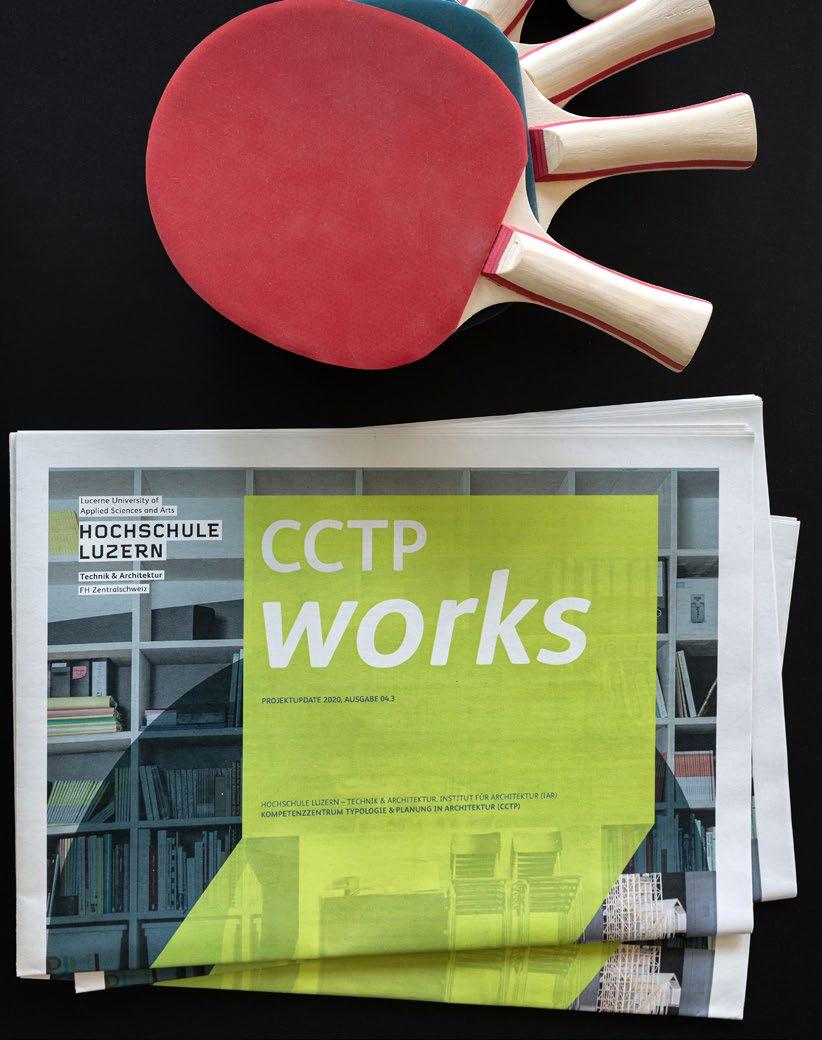
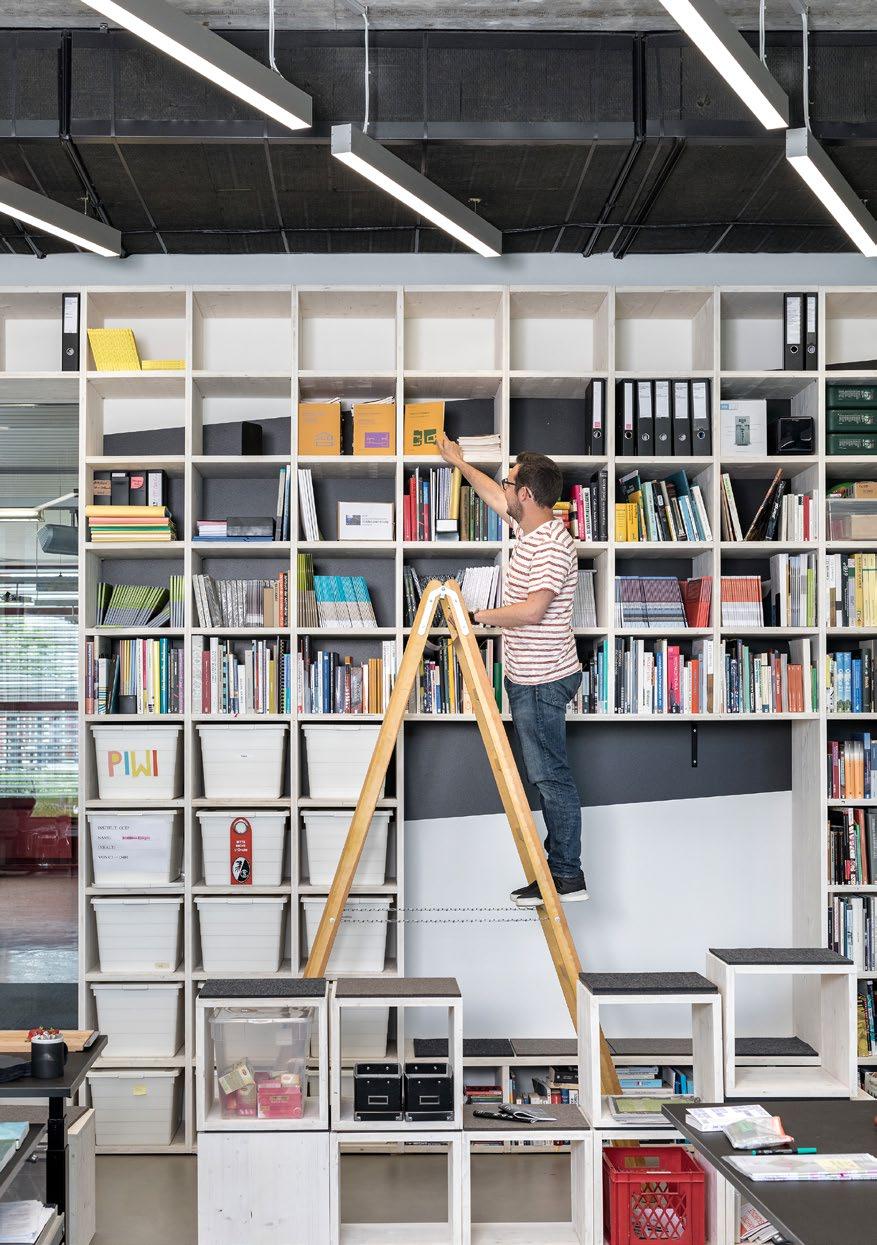
Research library at the Competence Center Typology and Planning.
Exchange of teaching and research, keynote lectures.
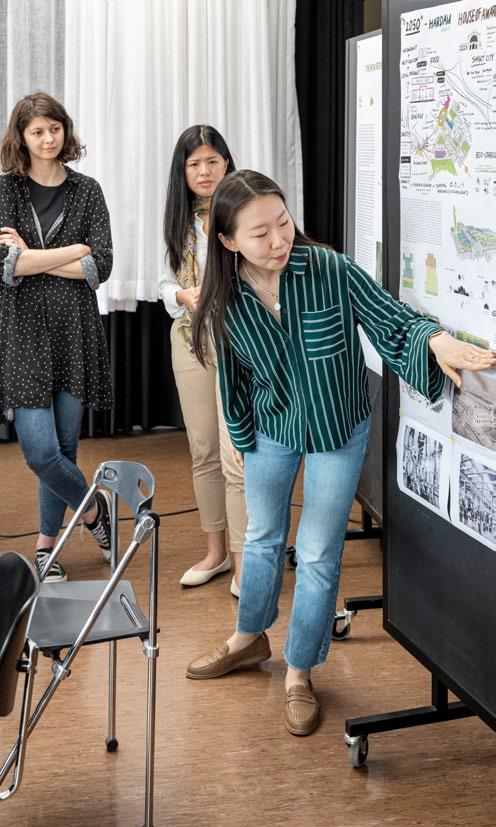
The architectural model as an important tool of the design studios.
Intense discussions at the Lucerne Talks.
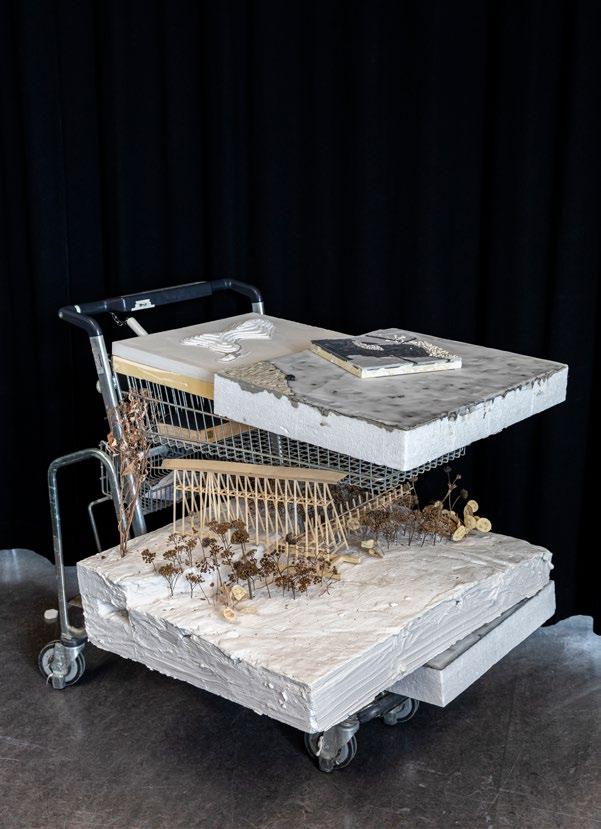
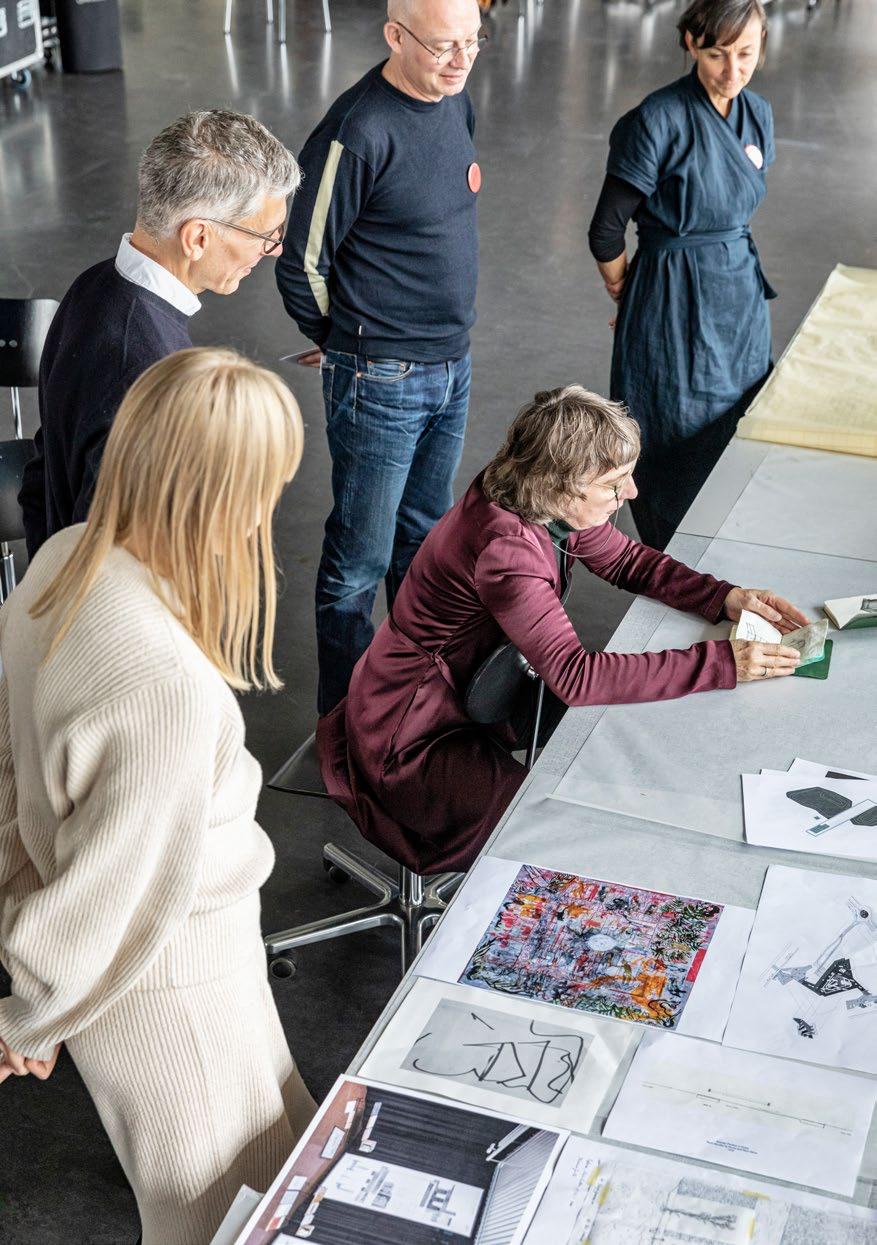
Ein Auslandssemester ist persönlich, fachlich und sozial eine grosse Bereicherung. Bei uns können Sie ein Semester des Studiums an einer von 34 Partneruniversitäten absolvieren.
Weitere Informationen finden Sie auf hslu.ch/ea-international
An exchange semester greatly enhances a student’s personal, professional and social life. You may complete one semester at one of our 34 partner universities abroad.
further information, visit hslu.ch/ea-international
Kooperationen: Partnerhochschulen im Ausland
Partner universities abroad
Bauhaus-Universität Weimar, Germany
Bergen School of Architecture, Norway
Brno University of Technology, Faculty of Architecture, Czech Republic
California Polytechnic State University (CalPoly), USA
Central Academy of Fine Arts (CAFA), Beijing, China
Czech Technical University in Prague, Czech Republic
École Nationale Supérieure d’Architecture de Saint Étienne, France
École Nationale Supérieure d’Architecture et de Paysage de Bordeaux, France
Escola Tècnica Superior d’Arquitectura del Vallès (ETSAV), Spain
Fachhochschule Münster, Faculty of Architecture, Germany
Fachhochschule Nordwestschweiz, Switzerland
HafenCity University, Hamburg, Germany
Indian Institute of Technology (IIT) Roorkee, India
Kyoto Institute of Technology (KIT), Japan
Misr International University, Egypt
Moscow Institute of Architecture (MARKHI), Russia
National Taiwan University of Science and Technology (Taiwan Tech), Taiwan
Norwegian University of Science and Technology (NTNU), Trondheim, Norway
Politecnico di Milano, Italy
Pontifícia Universidade Católica do Rio de Janeiro (PUC Rio), Brazil
Roma Tre University, Italy
SungKyunKwan University (SKKU), Seoul, South Korea
Technische Universität Darmstadt, Germany
The Glasgow School of Art, United Kingdom
Universidad de Monterrey (UDEM), Mexico
Universidad del Desarrollo, Santiago, Chile
Universidad Politècnica de València, ETSA, Spain
Universität Liechtenstein, Liechtenstein
Universiteit Antwerpen, Belgium
University College Dublin (UCD), Ireland
University of Illinois, College of Urban Planning and Public Affairs (CUPPA), Chicago, USA
University of Leuven (KU Leuven, Faculty of Architecture), Belgium
University of Oulu, Finland
Wentworth Institute of Technology, Boston, USA
Aus organisatorischen und administrativen Gründen wird eine Anmeldung bis spätestens vier Monate vor Studienbeginn empfohlen. Auch spätere Anmeldungen sind möglich. Melden Sie sich jetzt an: hslu.ch/jetzt
For organizational and administrative reasons, we recommend you sign up for the program at least four months before the commencement of studies. Later registrations are possible as well. Apply now on hslu. ch/jetzt
Günstigen Wohnraum finden Sie auf: stuwo.ch/luzern
For affordable accommodation: stuwo.ch/luzern
Ihr Ansprechpartner für alle Militärfragen ist Prof. Urs Grüter: urs.grueter@hslu.ch
Contact Prof. Urs Grüter for all Swiss military matters: urs.grueter@hslu.ch
Bei uns profitieren Sie von einem umfassenden Sportangebot: unilu.ch/uni-leben/sport
Lucerne UASA offers an attractive and wide-ranging sports program: unilu.ch/en/life-at-university/ sports/
Stipendienberatung
Möglicherweise erhalten Sie Stipendien. Wenn Sie in Erstaus bildung sind, wenden Sie sich bitte an den Wohnkanton Ihrer Eltern. Weitere Informationen finden Sie auf hslu.ch/stipendien
You may be eligible for grants or scholarships. If you are studying for your first degree, please contact your parents’ Canton or country of residence. For further information, visit hslu.ch/scholarships
In unseren Projekträumen und Labors arbeiten Sie praxisnah und interdisziplinär. Besonders praktisch: Die Fachbibliothek mit einem breiten Medienangebot ist nur zehn Schritte von der Mensa entfernt.
In our project spaces and labs, you will work with a practical and interdisciplinary focus. Particularly convenient: the technical library with its broad range of media is a short ten steps away from the cafeteria.
In unseren Studiengängen bereiten wir Sie optimal auf eine nach haltige und digital transformierte Berufswelt vor.
Get ready for a sustainable and digitally transformed working world with our degree programs.
Wollen Sie sich auf eine spätere Selbstständigkeit vorbereiten? Smart-up unterstützt Sie. hslu.ch/smart-up
Do you want to prepare yourself for future self-employment? The Smart-up scheme provides support and advice. hslu.ch/smart-up
Bei uns studieren Sie nach Ihren Bedürfnissen: Sie wählen das Zeitmodell, welches Ihnen zusagt, schliessen gezielt Lücken in Ihrer Vorbildung und bestimmen wesentliche Teile des Studiums selbst.
Our programs are designed to fit your needs. You can choose from a range of time models, shape the key elements of your program or fill specific gaps in your previous education.
Wir lehren an der Hochschule Luzern interdisziplinär. Sie arbeiten in Projektmodulen mit Studieren den anderer Richtungen intensiv zusammen. Über die Hälfte aller Module bieten wir für mehr als einen Studiengang an.
Teaching at our School is interdisciplinary. You will closely collaborate with students from other specializations – over half of our modules are available to students from more than one program.
Wir machen Sie fit für die künftige berufliche Herausforderung. Die Zusammenarbeit mit Industrie und Wirtschaft beginnt schon früh im Studium und zieht sich bis zu den Abschlussarbeiten durch.
We provide you with the skills for your future career. Students closely collaborate with real-life businesses throughout their program, including their thesis projects.
Lust auf Berge und See? Oder auf pulsierendes Stadtleben? Wir bieten beides. Unser Campus ist zentral gelegen und gut erreichbar. hslu.ch/ta-standort
Are you more of a mountain or a city person? Our campus is conveniently located and easy to reach from both rural and urban areas.
hslu.ch/ta-standort
Do you have any questions?
Our Bachelor & Master Secretariat will be happy to assist you: Lucerne School of Engineering and Architecture Technikumstrasse 21 6048 Horw
T +41 41 349 32 07 maa@hslu.ch hslu.ch/maa
Follow us! facebook.com/hslu.ch instagram.com/hslu_ta instagram.com/hslu.architecture Blog: hub.hslu.ch/ta-experience